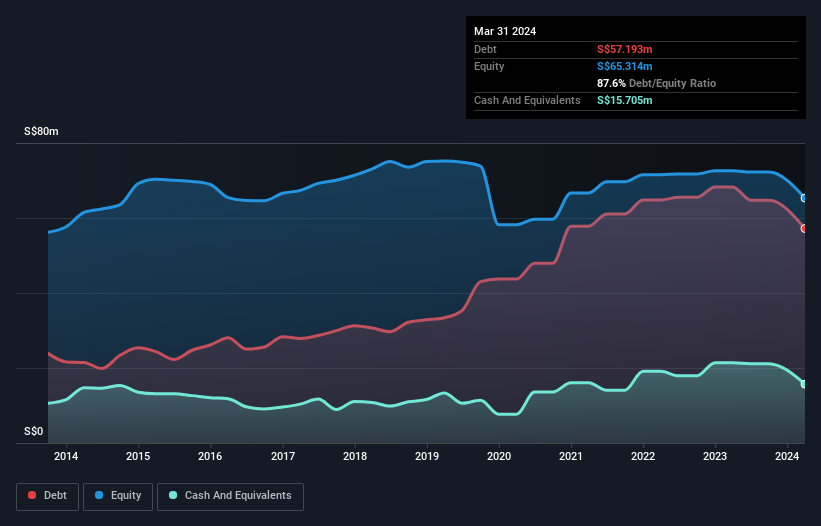Legendary fund manager Li Lu (who Charlie Munger backed) once said, 'The biggest investment risk is not the volatility of prices, but whether you will suffer a permanent loss of capital.' So it seems the smart money knows that debt - which is usually involved in bankruptcies - is a very important factor, when you assess how risky a company is. As with many other companies Chasen Holdings Limited (SGX:5NV) makes use of debt. But should shareholders be worried about its use of debt?
When Is Debt A Problem?
Debt is a tool to help businesses grow, but if a business is incapable of paying off its lenders, then it exists at their mercy. If things get really bad, the lenders can take control of the business. However, a more frequent (but still costly) occurrence is where a company must issue shares at bargain-basement prices, permanently diluting shareholders, just to shore up its balance sheet. Of course, debt can be an important tool in businesses, particularly capital heavy businesses. The first step when considering a company's debt levels is to consider its cash and debt together.
View our latest analysis for Chasen Holdings
What Is Chasen Holdings's Debt?
As you can see below, Chasen Holdings had S$57.2m of debt at March 2024, down from S$68.3m a year prior. However, it does have S$15.7m in cash offsetting this, leading to net debt of about S$41.5m.

A Look At Chasen Holdings' Liabilities
According to the last reported balance sheet, Chasen Holdings had liabilities of S$110.1m due within 12 months, and liabilities of S$28.5m due beyond 12 months. Offsetting these obligations, it had cash of S$15.7m as well as receivables valued at S$48.7m due within 12 months. So it has liabilities totalling S$74.2m more than its cash and near-term receivables, combined.
This deficit casts a shadow over the S$41.4m company, like a colossus towering over mere mortals. So we'd watch its balance sheet closely, without a doubt. After all, Chasen Holdings would likely require a major re-capitalisation if it had to pay its creditors today. The balance sheet is clearly the area to focus on when you are analysing debt. But you can't view debt in total isolation; since Chasen Holdings will need earnings to service that debt. So when considering debt, it's definitely worth looking at the earnings trend. Click here for an interactive snapshot.
Over 12 months, Chasen Holdings made a loss at the EBIT level, and saw its revenue drop to S$96m, which is a fall of 42%. That makes us nervous, to say the least.
Caveat Emptor
Not only did Chasen Holdings's revenue slip over the last twelve months, but it also produced negative earnings before interest and tax (EBIT). Its EBIT loss was a whopping S$8.3m. Considering that alongside the liabilities mentioned above make us nervous about the company. It would need to improve its operations quickly for us to be interested in it. It's fair to say the loss of S$11m didn't encourage us either; we'd like to see a profit. And until that time we think this is a risky stock. There's no doubt that we learn most about debt from the balance sheet. But ultimately, every company can contain risks that exist outside of the balance sheet. For example - Chasen Holdings has 2 warning signs we think you should be aware of.
At the end of the day, it's often better to focus on companies that are free from net debt. You can access our special list of such companies (all with a track record of profit growth). It's free.
New: AI Stock Screener & Alerts
Our new AI Stock Screener scans the market every day to uncover opportunities.
• Dividend Powerhouses (3%+ Yield)
• Undervalued Small Caps with Insider Buying
• High growth Tech and AI Companies
Or build your own from over 50 metrics.
Have feedback on this article? Concerned about the content? Get in touch with us directly. Alternatively, email editorial-team (at) simplywallst.com.
This article by Simply Wall St is general in nature. We provide commentary based on historical data and analyst forecasts only using an unbiased methodology and our articles are not intended to be financial advice. It does not constitute a recommendation to buy or sell any stock, and does not take account of your objectives, or your financial situation. We aim to bring you long-term focused analysis driven by fundamental data. Note that our analysis may not factor in the latest price-sensitive company announcements or qualitative material. Simply Wall St has no position in any stocks mentioned.
Have feedback on this article? Concerned about the content? Get in touch with us directly. Alternatively, email editorial-team@simplywallst.com
About SGX:5NV
Chasen Holdings
An investment holding company, provides logistics, and technical and engineering services in Singapore, Malaysia, Thailand, Vietnam, the People’s Republic of China, India, and the United States.
Slightly overvalued with very low risk.
Similar Companies
Market Insights
Community Narratives



